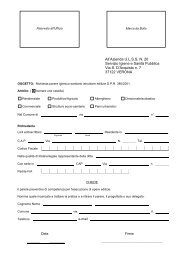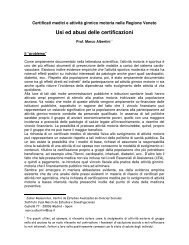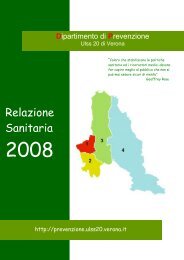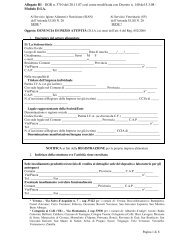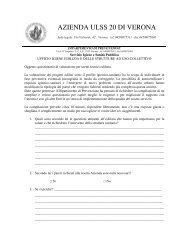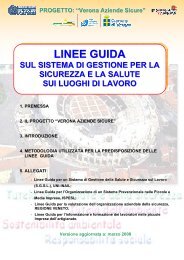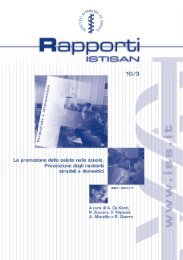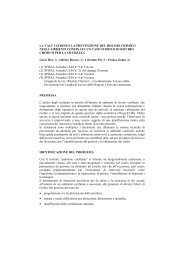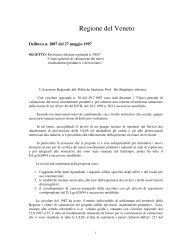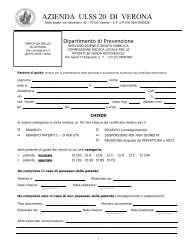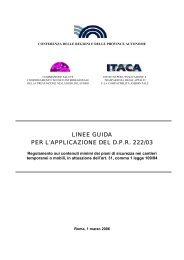Linee di indirizzo per la valutazione dell'organizzazione aziendale ...
Linee di indirizzo per la valutazione dell'organizzazione aziendale ...
Linee di indirizzo per la valutazione dell'organizzazione aziendale ...
You also want an ePaper? Increase the reach of your titles
YUMPU automatically turns print PDFs into web optimized ePapers that Google loves.
DIREZIONE PER LA<br />
PREVENZIONE<br />
GESTIONE INFORMAZIONE,<br />
FORMAZIONE, ADDESTRAMENTO<br />
Procedura n. 4<br />
E<strong>di</strong>zione:<br />
<strong>di</strong>cembre 2005<br />
SPISAL<br />
Per <strong>la</strong> formazione, informazione e l’addestramento dei soggetti addetti a compiti<br />
speciali l’Azienda fa riferimento a quanto stabilito dal<strong>la</strong> normativa:<br />
Formazione addetti emergenza: DM. 10.03.98 (4 ore <strong>per</strong> basso rischio incen<strong>di</strong>o, 8 ore<br />
<strong>per</strong> me<strong>di</strong>o rischio incen<strong>di</strong>o, 16 ore <strong>per</strong> alto rischio incen<strong>di</strong>o);<br />
Formazione addetti primo soccorso: DM 388/2003;<br />
Formazione RSPP: DM 16/01/97 N. 27 e D. Lgs 195/2003;<br />
Formazione RLS: DM 16/01/97 N. 27 (durata minima 36 ore).<br />
c) Soggetti incaricati (chi spiega le cose?).<br />
Tali soggetti possono essere ad esempio: Datore <strong>di</strong> <strong>la</strong>voro, RSPP, Me<strong>di</strong>co<br />
Competente, RLS, Preposto (partico<strong>la</strong>rmente in<strong>di</strong>cato <strong>per</strong> l’addestramento con<br />
affiancamento), Consulenti esterni. La scelta dei soggetti a cui affidare l’intervento<br />
viene condotta valutando anche <strong>la</strong> preparazione degli stessi rispetto al<strong>la</strong> tematica<br />
da trattare (es. corsi frequentati, es<strong>per</strong>ienza, titolo <strong>di</strong> stu<strong>di</strong>o, etc.).<br />
MOD 4.1 Piano tipo <strong>di</strong> in-formazione <strong>di</strong> base.<br />
MOD 4.2 Piano tipo <strong>di</strong> in-formazione sui rischi specifici.<br />
d) Metodologie <strong>di</strong>dattiche: (come fare?)<br />
Le metodologie da adottare possono essere:<br />
- Incontri, colloqui<br />
- esercitazioni pratiche in au<strong>la</strong> o in reparto (es. esercitazione <strong>per</strong> l’evacuazione in<br />
caso <strong>di</strong> emergenza)<br />
- addestramento sul <strong>la</strong>voro con affiancamento<br />
Sono privilegiate le metodologie che assicurano il maggior coinvolgimento dei<br />
destinatari.<br />
e) Strumenti: (con che cosa?). Ad esempio:<br />
- <strong>la</strong>vagna luminosa<br />
- luci<strong>di</strong><br />
- <strong>la</strong>vagna a fogli mobili<br />
- cartelloni<br />
- <strong>di</strong>spense<br />
- videoregistratore e televisore<br />
- videoproiettore<br />
f) Programmazione (quando?)<br />
Il programma delle attività <strong>di</strong> informazione, formazione e addestramento deve<br />
essere redatto utilizzando il MOD 4.3 Piano del<strong>la</strong> informazione, formazione e<br />
addestramento.<br />
Le attività devono essere ripetute <strong>per</strong>io<strong>di</strong>camente e comunque sempre in<br />
occasione <strong>di</strong> nuove assunzioni, cambi mansioni, cambiamenti organizzativi<br />
(attrezzature, tecnologie, macchinari, sostanze e preparati <strong>per</strong>icolosi).<br />
g) Valutazione: (l’intervento è stato efficace?). Ad esempio:<br />
- Questionari/test <strong>di</strong> verifica dell’appren<strong>di</strong>mento<br />
- osservazione del comportamento dei <strong>la</strong>voratori dopo l’intervento<br />
- addestramento in seguito al<strong>la</strong> lezione teorica<br />
- controllo dello stato <strong>aziendale</strong> <strong>di</strong> infortuni, incidenti, comportamenti <strong>per</strong>icolosi.<br />
3) Realizzazione dell’intervento.<br />
Allegato1_SGS_Regione_UNI_INAIL - aggiornamento aprile 2007- 15 / 25



